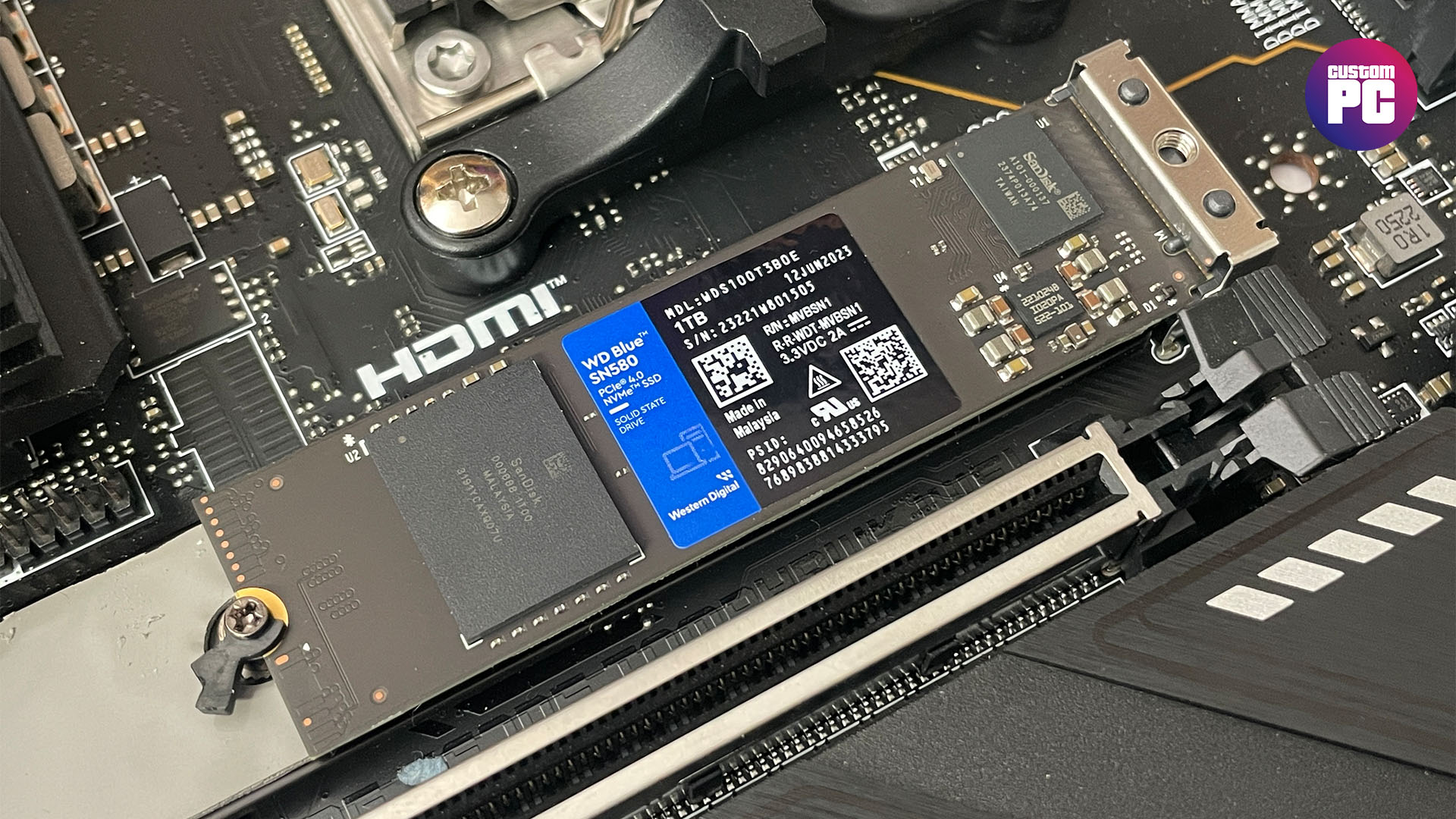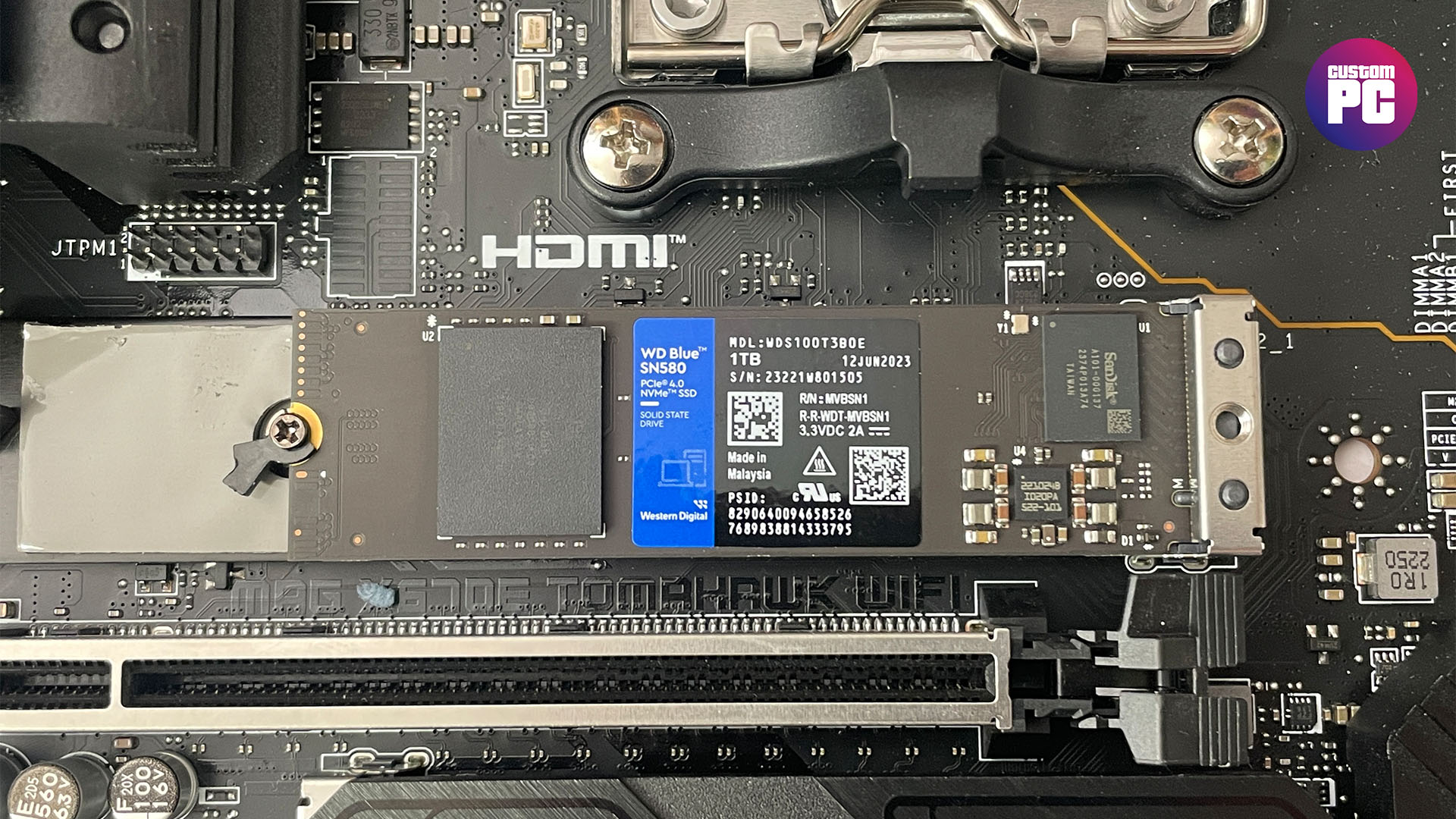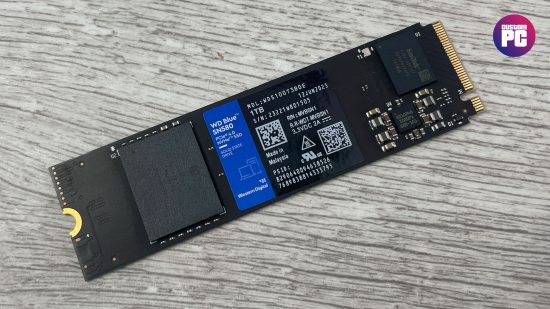Our Verdict
84%A good choice of SSD for those on tight budgets, but it’s not ideal for regular big file transfers.
Building a PC on a budget means cutting costs at every turn, but the benefits of super-fast SSDs should never come at the expense of cutting capacity, forcing you to constantly delete games to make space for new ones. The WD Blue SN580 is the successor to the popular and affordable SN570, offering 1TB of space for just $55 and 500GB for $38. However, this is a PCIe 4.0 SSD with read speeds up to 4,150MB/sec, so you’ll be getting decent performance as well as low cost per gigabyte.
WD Blue SN580 features
As the M.2 SSD market shifts from PCIe 3.0 to PCIe 4.0 for its baseline in terms of value, there’s inevitably an uptick in terms of performance and here the WD Blue SN580 adds 600MB/sec to the read speed and nearly 900MB/sec to the write speed of the Blue SN570. Of course, you’ll need a PCIe 4.0 M.2 slot to get its rated speeds, but these are present on practically every motherboard bought new right now, plus plenty of older models too.
Unless you’re on a supremely tight budget, we’d suggest staying away from the 250GB model as this will get swallowed up rapidly by Windows and games, plus it’s often only $5 more for the 500GB option. The 500GB model at $35 will give you much more breathing room, but does have slightly slower speeds than the 1TB option, which again isn’t all that much more in some instances, with it widely available for $55 or £54.

All models use a WD in-house SanDisk 20-82-10082 controller and with our 1TB, it had a usable capacity of 931GB once formatted. You also don’t need a heatsink as our 1TB model never topped 70°C during our stress test.
Part of the reason the Blue SN580 can offer such a low cost per gigabyte is the lack of a DRAM buffer. These buffers are used to help deliver peak write speeds but here instead WD has setup the SSD to operate some of the NAND in 1-bit SLC mode instead rather than the slower 3-bit TLC that makes up the rest of the drive’s storage, to help ensure speedier write operations. Once the drive gets a moment of down time, the data is then written out to TLC for long term storage.
The issue here is that, eventually, that SLC portion will fill up and then the SSD has no option but to write directly to TLC, which is much slower. With the WD Blue SN580, that will happen with files of 300-400MB or more, where you’ll see speeds cut by up to 75%. It’s also worth noting that the endurance rating is lower for the 2TB model at 900TBW than more expensive models, which boast around 1,200TBW.
WD Blue SN580 sequential performance
The SN580’s CrystalDiskMark sequential speeds of 4,183MB/sec read and 4,147MB/sec write and the AS SSD benchmark’s 3,531MB/sec read and 3,846MB/sec write figures pale in comparison to faster PCIe 4.0 SSDs which manage around 7,000MB/sec. But that’s why those drives cost $15-20 more for a 1TB model.
By comparison, spending even more per gigabyte and opting for a PCIe 5.0 SSD such as Crucial’s T700 will see those speeds tripled, but so is the price.
WD Blue SN580 random performance
The random 4K performance of the SN580 was also a fair bit slower than the fastest PCIe 4.0 SSDs we’ve seen, with the Solidigm P44 Pro hitting 87MB/sec read and 343MB/sec write in CrystalDiskMark’s Q1T1 random 4K test compared to 73MB/sec and 227MB/sec respectively for the WD Blue SN580.
The Q32 T16 test resulted in read and write speeds of 2,539MB/sec and 3,373MB/sec, which again were noticeably slower than the 5,900MBsec for reads and 5,092MB/sec for the Solidigm P44 Pro.
WD Blue SN580 real world performance
The PCMark 10 full drive benchmark features real world tests such as mimicking Windows and game boot times, applications loading times and performing tasks within them.
Here the WD Blue SN580’s score of 2,921 wasn’t too far away from the 3,754MB/sec recorded by the far pricier Crucial T700, which goes to show that even though its sequential speeds were three times as fast, when it comes to dealing with software, it’s certainly not doing things three times as fast.

WD Blue SN580 Pros and cons
Pros
- Good sequential speeds for the cash
- Excellent value and low cost per gigabyte
- No need for a headsink
Cons
- Much faster PCIe 4.0 SSDs only cost a little more
- No significant benefits over previous generation
- No 4TB option
WD Blue SN580 specs
| Full capacity | 1TB |
| Formatted capacity | 931TB |
| Heatsink option | No |
| Capacities available | 250GB, 500GB, 1TB (tested), 2TB |
| NAND | TLC |
| Controller | SanDisk 20-82-10082 |
| Endurance rating | 900 TBW (1TB model) |
| Warranty | Five years |
WD Blue SN580 price
The WD Blue SN580 price is $58 for 1TB, $30 for 250GB, $35 for 500GB, or $110 for 2TB. As such, the WD Blue SN580 is certainly budget friendly and 500GB, but WD’s own Black SN850X costs just $20 more for 1TB.
Price: Expect to pay $58 (£50) for 1TB.
WD Blue SN580 review conclusion
If saving every dollar counts and you won’t be throwing more than a few hundred megabytes at it on a regular basis, the WD Blue SN580 is a good choice in nearly all capacities, although we’d suggest staying away from the 250GB option given how little space you’ll be left with once Windows is installed.
While it’s noticeably slower in peak speed sequential tests than the fastest PCIe 4.0 SSDs we’ve seen, in random 4K tests and PCMark 10’s real world drive benchmark, this drive can hold its own. Many PCIe 4.0 SSDs capable of 7000MB/sec or more will be a slightly better buy given the small extra outlay, but if you’d rather put the extra 30 bucks towards a quieter CPU cooler or better case, then it’s still a solid if unremarkable SSD.
For more SSD choices, check out our best SSD for gaming guide, and if you’d like to let us know your thoughts on the SN850, you can do so via the Custom PC Facebook page, via Twitter, or by joining our Custom PC and Gaming Setup Facebook group and tap into the knowledge of our 420,000+ members.
